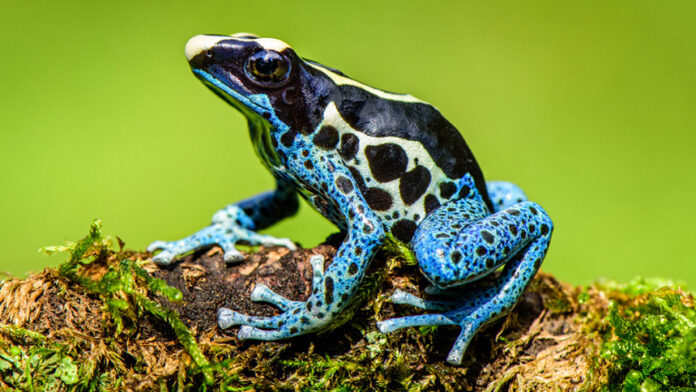Meet the Terrible Leaf Walker Frog, the most poisonous frog in the world. Belonging to the family of tree frogs, it is an endemic species of Colombia. Although this amphibian is listed in the Red Book, its notability extends beyond that. If you ever encounter this frog on your path, refrain from touching it. Just a mere touch of any part of its body can be lethal, and there is no antidote.
Interesting Facts About the Terrible Leaf Walker Frog
- Toxicity: The Terrible Leaf Walker Frog is one of the five species of tree frogs that accumulate batrachotoxin in their bodies (skin glands). Each individual contains about 1000 micrograms of poison. For humans, a lethal dose is considered to be just 2 micrograms from a simple touch. Death occurs within 8 minutes due to cardiac (respiratory) failure. An antidote has not yet been found.
- Diet and Toxicity: Surprisingly, the leaf-frog is not born poisonous. Its toxicity is the result of its diet, which includes ants and beetles. According to some studies, the venom’s activity persists for up to a year.
- Habitat: The Terrible Leaf Walker Frog only inhabits Colombia and prefers to settle in the lower canopy of tropical forests. Locals have been known to use its venom to smear arrowheads.
Description of the Species
- Size and Lifespan: The most poisonous frog in the world grows to a size of no more than 5 cm and lives for about 6 years. In captivity, it can live twice as long.
- Coloration: It is brightly colored, mostly golden-yellow, and lacks the dark spots typical of other tree frogs.
- Lifestyle: The leaf-frog leads a diurnal terrestrial lifestyle. Suckers on the tips of its toe pads help it crawl along tree trunks, and it lacks the webbing typical of tree frogs.
- Physical Features: There are no teeth on its lower jaw. It has an excellent reaction and easily navigates through space, allowing it to hunt without difficulty during the day. It produces sounds resembling melodious trills.
- Defense Mechanisms: The Terrible Leaf Walker Frog does not flee when threatened. Its only natural enemy is the arboreal snake, which is immune to the frog’s venom.
- Conservation: Hunting the Terrible Leaf Walker Frog is prohibited by law due to the threat of its extinction, mainly caused by the deforestation of tropical forests.
Reproduction
- Group Living: The leaf-frog lives in groups of no more than 10 individuals. Sexual maturity is reached at 18-20 months, but it depends more on its size (males – 37 mm, females – 40 mm).
- Breeding Season: The breeding period occurs during the rainy season. The frog lays its eggs (up to 30) in a moist place on land, such as soil or plant leaves of bromeliads. The process takes about 20 hours.
- Parental Care: The male cares for the eggs, maintaining the necessary humidity level and stirring the clutch. After hatching, the tadpoles are carried to water on the male’s back. The journey in search of a suitable body of water can last for a week. Young frogs are ready for terrestrial life in 2-3 weeks.
A Few More Interesting Facts
- Hunger Tolerance: The leaf-frog tolerates hunger poorly. Just three days without food can kill it due to its amphibian mobility and accelerated metabolism.
- Territorial Behavior: The animal is territorial and defends its territory against any encroachment. A fight between leaf-frogs resembles free combat.
- Intelligence: It is considered one of the most intelligent amphibians. In captivity, it can recognize its owner in just a couple of weeks.
- Venom Use: The leaf-frog is peaceable and uses its venom only for self-defense.
- Popularity Among Exotic Animal Enthusiasts: It is popular among exotic animal enthusiasts because it can lose its toxicity in captivity.
